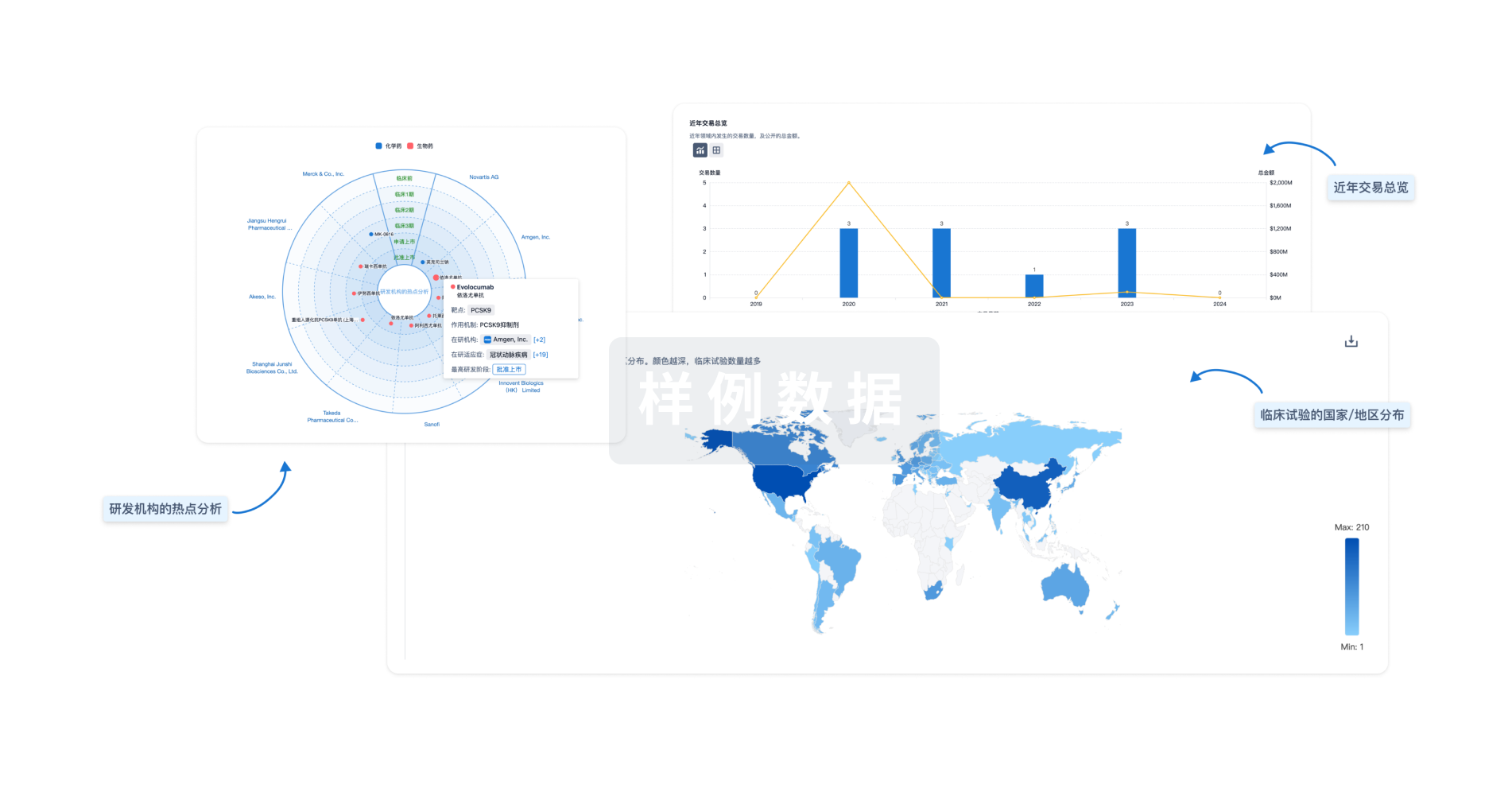预约演示
更新于:2025-05-07
ADA2
更新于:2025-05-07
基本信息
别名 ADA2、adenosine deaminase 2、ADGF + [3] |
简介 Adenosine deaminase that may contribute to the degradation of extracellular adenosine, a signaling molecule that controls a variety of cellular responses. Requires elevated adenosine levels for optimal enzyme activity. Binds to cell surfaces via proteoglycans and may play a role in the regulation of cell proliferation and differentiation, independently of its enzyme activity. |
关联
2
项与 ADA2 相关的药物靶点 |
作用机制 ADA2 modulators |
在研适应症 |
非在研适应症- |
最高研发阶段临床前 |
首次获批国家/地区- |
首次获批日期1800-01-20 |
靶点 |
作用机制 ADA2 agonists |
在研适应症 |
非在研适应症- |
最高研发阶段临床前 |
首次获批国家/地区- |
首次获批日期1800-01-20 |
100 项与 ADA2 相关的临床结果
登录后查看更多信息
100 项与 ADA2 相关的转化医学
登录后查看更多信息
0 项与 ADA2 相关的专利(医药)
登录后查看更多信息
630
项与 ADA2 相关的文献(医药)2025-12-01·Journal of Clinical Immunology
Deficiency of Adenosine Deaminase 2 Masquerading as Behçet’s Disease: Phenotypic Mimicry with HLA-B*51 Positivity
Article
作者: Alrasheed, Abdulrahman ; Alqanatish, Jubran ; Alharbi, Bushra ; Almojali, Abdullah ; Alroqi, Fayhan ; Alharbi, Reem ; Alsuwairi, Wafaa
2025-12-01·Journal of Clinical Immunology
A large cohort from an immunology reference center and an algorithm for the follow-up of chronic neutropenia
Article
作者: Ergenoğlu, Damla Nur ; Cagdas, Deniz ; Maslak, Ibrahim Cemal ; Çiçek, Begüm ; Bildik, Hacer Neslihan ; Esenboga, Saliha ; Sinanoğlu, Nidanur ; Tezcan, Ilhan ; Caka, Canan
2025-06-01·Pediatric Blood & Cancer
A Novel Mutation in the Adenosine Deaminase‐2 Gene Presenting as Severe Chronic Neutropenia With Myeloid Hypoplasia
Letter
作者: Naithani, Rahul ; Rath, Prasan Deep ; Dayal, Nitin ; Jeyaraman, Preethi ; Borah, Pronamee
1
项与 ADA2 相关的新闻(医药)2025-02-19
·学术经纬
▎药明康德内容团队编辑(来源:浙江大学良渚实验室)
系统性红斑狼疮(Systemic lupus erythematosus, SLE)是一种由遗传与环境因素共同驱动的多系统慢性自身免疫性疾病。该病可累及皮肤、关节、中枢神经系统和肾脏等,临床表现复杂多样。患者通常表现出全身性炎症、反复发热、皮疹、关节炎等症状,部分病例还可伴有颅内钙化、蛋白尿及自身免疫性血细胞减少等异常。
SLE不仅是典型的系统性自身免疫病之一,同时也是临床异质性最为显著的疾病之一。其高度可变的病程和症状模式对精准诊断和靶向治疗带来了极大的挑战,亟需深入探索其分子机制,以优化个性化治疗策略。
近日,良渚实验室/浙江大学附属邵逸夫医院周青教授,俞晓敏研究员在风湿病学领域刊物Annals of the Rheumatic Diseases发表了题为“Somatic gain-of-function mutation in TLR7 causes early onset systemic lupus erythematosus”的研究论文,该研究首次报道了TLR7体细胞突变(p.F506S)导致的SLE,明确了TLR7 F506S突变增强了其对ssRNA的结合能力,为功能获得性突变;TLR7 介导的NF-κB和IFN信号通路的上调,导致了患者的临床表型。致病基因和致病机制的明确为患者后续的靶向治疗提供了理论依据。
长期以来,尽管遗传因素在SLE的发病中的重要作用已是共识,但其确切作用始终未得到揭示。近年来,数个遗传学研究表明单基因突变即可导致SLE,单基因狼疮的概念呼之欲出。然而临床上数量庞大的SLE患者得到明确遗传学解释的仍然是少数,这提示SLE发病的遗传基础仍然有待进一步研究。
在本研究中,研究团队通过高通量测序方法,在未得到明确遗传学诊断的SLE患者中鉴定到了一名携带TLR7 F506S体细胞突变的男性患者,对患者全血、中性粒细胞、单核细胞、T细胞、B细胞、DCs细胞、头发、指甲、唾液以及指甲进行靶向测序,发现突变等位基因频率约占体细胞的40%(图1)。
临床资料表明患者具有8年的反复炎症、7年的血小板减少症以及4年的蛋白尿病史。患者较早的发病史提示了遗传因素在疾病中的重要作用;此外TLR7作为一种定位于内体上的Toll样受体,可以识别病毒单链RNA以及由U或hY RNAs和相关自身抗体组成的含RNA的免疫复合物,激活诱导I型干扰素(IFN)的产生,TLR7诱导激活的免疫系统被认为对于SLE的发展具有重要作用。因此,研究团队对患者携带的TLR7 F506S体细胞突变进行了详细探究。
▲图1 一例TLR7 F506S体细胞突变导致的早发型SLE(图片来源:原始论文[1])
进一步的查体发现患者表现出CRP和ESR的升高、自身抗体阳性以及颅内钙化。患者血浆中促炎细胞因子如IL-8,IFN-α和IP-10水平显著升高,转录组分析表明,患者外周血单个核细胞(PBMCs)中的I型干扰素通路的基因转录水平均显著升高。
机制研究发现,TLR7 F506S突变增强了TLR7对其配体的识别能力。在HEK293T细胞中,当使用R848,CL307以及Guanosine进行刺激时,NF-κB信号通路显著激活。此外,由于TLR7可以特异性识别并结合G-rich ssRNA,团队使用带生物素标签的G-rich ssRNA进行TLR7的pull down实验,发现与WT的TLR7相比,TLR7 F506S突变增强了与ssRNA的结合能力,说明突变增强了TLR7对其激动剂的亲和力,从而增强其对下游炎症信号通路的激活(图2)。
在TLR7的激动剂刺激下,患者PBMCs相较于正常对照组,表现出明显增强的I型干扰素和NF-κB炎症信号,特别是患者CD19+ B细胞群体表现出对ssRNA刺激的强烈响应,表现出升高的IL-6,TNF,IL-1β,以及IFN-α信号,而CD14+ 单核细胞则表现出对R848响应。在以往的研究中报道了I型干扰素信号以及核酸识别受体在神经系统疾病发展中具有非常重要的作用,TLR7增强的配体识别能力以及过度激活的下游信号,特别是I型干扰素信号可能是患者脑部钙化以及神经炎症的内在驱动因素之一。
▲图 2 TLR7 F506S突变增强了TLR7对其激动剂的响应(图片来源:原始论文[1])
总的来说,本研究发现了第一例由于TLR7体细胞突变导致的自身免疫性疾病,该突变通过增强TLR7对其配体的识别能力,导致TLR7及其信号通路的过度激活,炎症因子上调。该病例的发现和研究有助于完善SLE和相关自身免疫性疾病的分类,强调体细胞突变在疾病发生和进展中的作用,对SLE的诊断和治疗提供了新的见解,为患者后续的靶向治疗提供了理论依据。
良渚实验室/浙江大学附属邵逸夫医院周青教授、浙江大学生命科学学院陶攀峰研究员、良渚实验室俞晓敏研究员、北京协和医院宋红梅教授为本文通讯作者。浙江大学曾已、陶攀峰博士和王俊博士、北京协和医院李婷博士和盛京医院杜悦教授为本文的共同第一作者。
周青,浙江大学求是特聘教授,国家杰出青年科学基金获得者,长期专注自身炎症性疾病的研究。发现并命名CRIA, DADA2, LIRSA, HA20, Otulipenia, APLS, APLAID等新自身炎症性疾病;研究发现RIPK1,ADA2,IL1R1, TNFAIP3, OTULIN, PLCG1, PLCG2等自身炎症性疾病的新致病基因以及NLRP3和NLRC4体细胞突变;深入研究自身炎症性疾病致病机制, 首次报道细胞死亡和去泛素化缺陷可导致自身炎症性疾病。通过致病机制的研究推动对病人的靶向治疗, 成功治疗6种自身炎症性疾病。
团队现面向海内外公开招聘浙江大学百人计划研究员,特聘研究员/副研究员和优秀博士后名额不限,期待与优秀的科研人员共同组建研究中心,开展富有创造性和挑战的研究工作。
原始论文:
[1]Somatic gain-of-function mutation in TLR7 causes early onset systemic lupus erythematosus. Annals of the Rheumatic Diseases (2025). DOI:10.1016/j.ard.2025.01.011
免责声明:药明康德内容团队专注介绍全球生物医药健康研究进展。本文仅作信息交流之目的,文中观点不代表药明康德立场,亦不代表药明康德支持或反对文中观点。本文也不是治疗方案推荐。如需获得治疗方案指导,请前往正规医院就诊。
更多推荐
点个“在看”再走吧~
临床研究基因疗法
分析
对领域进行一次全面的分析。
登录
或

生物医药百科问答
全新生物医药AI Agent 覆盖科研全链路,让突破性发现快人一步
立即开始免费试用!
智慧芽新药情报库是智慧芽专为生命科学人士构建的基于AI的创新药情报平台,助您全方位提升您的研发与决策效率。
立即开始数据试用!
智慧芽新药库数据也通过智慧芽数据服务平台,以API或者数据包形式对外开放,助您更加充分利用智慧芽新药情报信息。
生物序列数据库
生物药研发创新
免费使用
化学结构数据库
小分子化药研发创新
免费使用

